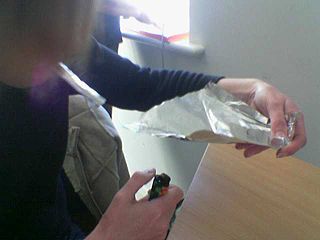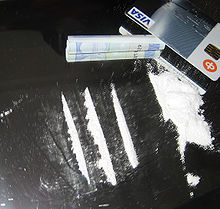
Recreational drug use is the use of one or more psychoactive drugs to induce an altered state of consciousness, either for pleasure or for some other casual purpose or pastime. When a psychoactive drug enters the user's body, it induces an intoxicating effect. Recreational drugs are commonly divided into three categories: depressants, stimulants, and hallucinogens.

Harm reduction, or harm minimization, refers to a range of intentional practices and public health policies designed to lessen the negative social and/or physical consequences associated with various human behaviors, both legal and illegal. Harm reduction is used to decrease negative consequences of recreational drug use and sexual activity without requiring abstinence, recognizing that those unable or unwilling to stop can still make positive change to protect themselves and others.

Club drugs, also called rave drugs or party drugs, are a loosely defined category of recreational drugs which are associated with discothèques in the 1970s and nightclubs, dance clubs, electronic dance music (EDM) parties, and raves in the 1980s to today. Unlike many other categories, such as opiates and benzodiazepines, which are established according to pharmaceutical or chemical properties, club drugs are a "category of convenience", in which drugs are included due to the locations they are consumed and/or where the user goes while under the influence of the drugs. Club drugs are generally used by adolescents and young adults.

A needle and syringe programme (NSP), also known as needle exchange program (NEP), is a social service that allows injecting drug users (IDUs) to obtain clean and unused hypodermic needles and associated paraphernalia at little or no cost. It is based on the philosophy of harm reduction that attempts to reduce the risk factors for blood-borne diseases such as HIV/AIDS and hepatitis.

Supervised injection sites (SIS) or drug consumption rooms (DCRs) are a health and social response to drug-related problems. They are fixed or mobile spaces where people who use drugs are provided with sterile drug use equipment and can use illicit drugs under the supervision of trained staff. They are usually located in areas where there is an open drug scene and where injecting in public places is common. The primary target group for DCR services are people who engage in risky drug use.
Needle sharing is the practice of intravenous drug-users by which a needle or syringe is shared by multiple individuals to administer intravenous drugs such as heroin, steroids, and hormones. This is a primary vector for blood-borne diseases which can be transmitted through blood. People who inject drugs (PWID) are at an increased risk for Hepatitis C (HCV) and HIV due to needle sharing practices. From 1933 to 1943, malaria was spread between users in the New York City area by this method. Afterwards, the use of quinine as a cutting agent in drug mixes became more common. Harm reduction efforts including safe disposal of needles, supervised injection sites, and public education may help bring awareness on safer needle sharing practices.

The National Institute on Drug Abuse (NIDA) is a United States federal government research institute whose mission is to "advance science on the causes and consequences of drug use and addiction and to apply that knowledge to improve individual and public health."
Substance dependence, also known as drug dependence, is a biopsychological situation whereby an individual's functionality is dependent on the necessitated re-consumption of a psychoactive substance because of an adaptive state that has developed within the individual from psychoactive substance consumption that results in the experience of withdrawal and that necessitates the re-consumption of the drug. A drug addiction, a distinct concept from substance dependence, is defined as compulsive, out-of-control drug use, despite negative consequences. An addictive drug is a drug which is both rewarding and reinforcing. ΔFosB, a gene transcription factor, is now known to be a critical component and common factor in the development of virtually all forms of behavioral and drug addictions, but not dependence.

Polysubstance use or poly drug use refers to the use of combined psychoactive substances. Polysubstance use may be used for entheogenic, recreational, or off-label indications, with both legal and illegal substances. In many cases one drug is used as a base or primary drug, with additional drugs to leaven or compensate for the side effects, or tolerance, of the primary drug and make the experience more enjoyable with drug synergy effects, or to supplement for primary drug when supply is low.

"Chasing the dragon" (CTD), or "foily" in Australian English, refers to inhaling the vapor of a powdered psychoactive drug off a heated sheet of aluminium foil. The moving vapor is chased after with a tube through which the user inhales. The "chasing" occurs as the user gingerly keeps the liquid moving in order to keep it from overheating and burning up too quickly, on a heat conducting material such as aluminium foil.

Insite is a supervised drug injection site in the Downtown Eastside (DTES) neighbourhood of Vancouver, British Columbia, Canada The DTES had 4,700 chronic drug users in 2000 and has been considered to be the centre of an "injection drug epidemic". The site provides a supervised and health-focused location for injection drug use, primarily heroin. The clinic does not supply any drugs. Medical staff are present to provide addiction treatment, mental health assistance, and first aid in the event of an overdose or wound. In 2017, the site recorded 175,464 visits by 7,301 unique users; 2,151 overdoses occurred with no fatalities, due to intervention by medical staff. The site also offers a free checking service so clients can check their substances for fentanyl and carfentanil. Health Canada has provided $500,000 per year to operate the site, and the BC Ministry of Health contributed $1,200,000 to renovate the site and cover operating costs. Insite also serves as a resource for those seeking to use a harm reduction approach for people who inject drugs around the world. In recent months and years, delegations from a number of countries are on record touring the facility, including various U.S. states, Colombia and Brazil. 95% of drug users who use Insite also inject on the street according to a British Columbia health official.

Drug injection is a method of introducing a drug into the bloodstream via a hollow hypodermic needle, which is pierced through the skin into the body. Intravenous therapy, a form of drug injection, is universally practiced in modernized medical care. As of 2004, there were 13.2 million people worldwide who self-administered injection drugs outside of medical supervision, of which 22% are from developed countries.

Drug liberalization is a drug policy process of decriminalizing or legalizing the use or sale of prohibited drugs. Variations of drug liberalization include drug legalization, drug relegalization, and drug decriminalization. Proponents of drug liberalization may favor a regulatory regime for the production, marketing, and distribution of some or all currently illegal drugs in a manner analogous to that for alcohol, caffeine and tobacco.
Illicit drug use in Australia is the recreational use of prohibited drugs in Australia. Illicit drugs include illegal drugs, pharmaceutical drugs when used for non-medical purposes, and other substances used inappropriately. According to government and community organisations, the use and abuse, and the illegality, of illicit drugs is a social, health and legal issue that creates an annual illegal market estimated to be worth A$6.7 billion. Estimates made in 2022 place the figure at A$11.3 billion per year.

The Vancouver Area Network of Drug Users or VANDU is a not-for-profit organization and advocacy group based in Vancouver, British Columbia, Canada. The group believes that all drug users should have their own rights and freedoms. The group's members have been actively involved in lobbying for support of Insite, North America's first safe injection site, located in the Downtown Eastside of Vancouver.

A psychoactive drug, psychopharmaceutical, psychoactive agent, or psychotropic drug is a chemical substance that changes the function of the nervous system and results in alterations of perception, mood, cognition, and behavior. These substances have various applications, including medical use like psychedelic therapy, recreationally, or for spiritual reasons. Some categories of psychoactive drugs may be prescribed by physicians and other healthcare practitioners because of their therapeutic value.
Discrimination against drug addicts is a form of discrimination against people who suffer from a drug addiction.
Liz Evans is a Canadian nurse and harm reduction pioneer. She is the founder of the nonprofit Portland Hotel Society and a cofounder of North America's first sanctioned supervised-injection facility, Insite.
Harm reduction consists of a series of strategies aimed at reducing the negative impacts of drug use on users. It has been described as an alternative to the U.S.'s moral model and disease model of drug use and addiction. While the moral model treats drug use as a morally wrong action and the disease model treats it as a biological or genetic disease needing medical intervention, harm reduction takes a public health approach with a basis in pragmatism. Harm reduction provides an alternative to complete abstinence as a method for preventing and mitigating the negative consequences of drug use and addiction.
Access, Harm Reduction, Overdose Prevention and Education, commonly referred to as AHOPE Boston or AHOPE Needle Exchange, and formerly called Addicts Health Opportunity Prevention Education, is a needle exchange and public health initiative of the Boston Public Health Commission.














